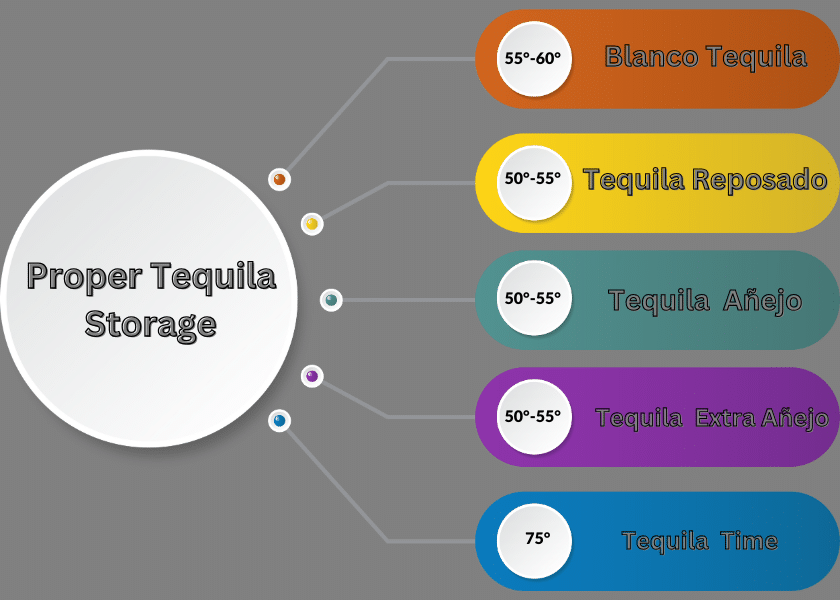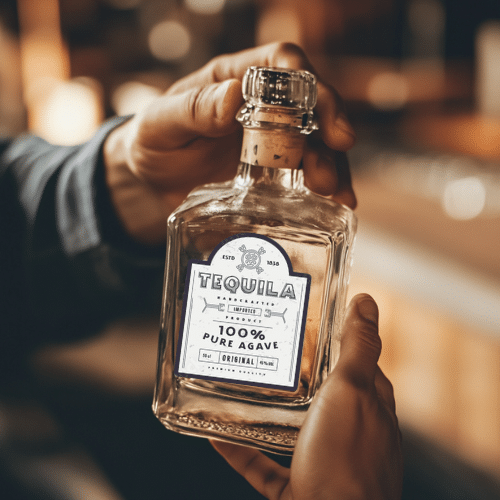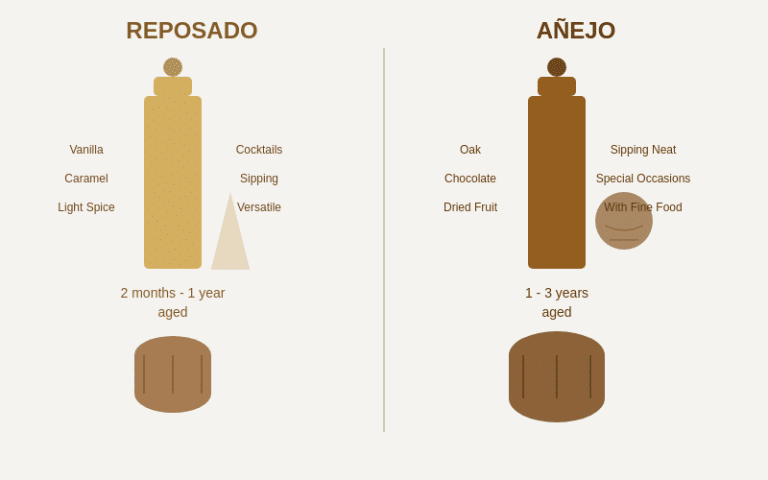Proper Tequila Storage: A Complete Guide
I still remember the day I brought home my first “good” bottle of tequila. It felt like a…

I still remember the day I brought home my first “good” bottle of tequila. It felt like a splurge—a stunning añejo that set me back nearly a week’s grocery budget. I showcased it proudly on my kitchen windowsill, where the afternoon sun would illuminate that amber liquid, making it glow like honey. Fast forward three months, and I was baffled by the strange taste. It turns out I had been cooking my precious tequila daily with that sunbeam, completely neglecting proper tequila storage. Rookie mistake!
Let me share what I’ve learned about proper tequila storage to help you avoid my costly mistakes.
- Tequila can be damaged by four main factors: oxygen contact (after opening), light exposure (particularly UV rays), heat, and temperature fluctuations, which can lead to flavor degradation in as little as 3-4 weeks of sunlight exposure.
- The ideal storage temperature for tequila is between 60-68°F (15-20°C), with añejos preferring the cooler end of that range, and consistency is more important than hitting an exact temperature.
- Tequila bottles should always be stored upright (never on their sides) to prevent the high alcohol content from deteriorating the cork, and in dark locations away from heat sources like ovens or dishwashers.
- Opened bottles have different shelf-life timelines: blancos last 1-2 years, reposados 6-9 months, añejos 3-6 months, and extra añejos just 2-3 months when stored properly.
- For preserving opened bottles, techniques include transferring to smaller containers to minimize air contact, using vacuum stoppers, or using inert gas preservation systems that replace oxygen with non-reactive argon.

Understanding Tequila Basics and Why Proper Storage Matters
First things first: understanding what tequila actually is helps explain why storage matters so much. Tequila is made from the blue agave plant, specifically the piña (the heart of the plant). These piñas are harvested, cooked, fermented, and then distilled. The production process influences stability right from the start.
Here’s the thing about agave spirits preservation – they’re incredibly complex chemically. A single bottle can contain over 600 different chemical compounds. That’s what gives tequila its distinct flavor profile, but it’s also why proper storage is crucial.
Let’s break down the main types of tequila, because each has slightly different storage needs:
- Blanco tequila storage is relatively straightforward since it’s unaged or aged less than 2 months. It’s the most stable variety but still requires protection from heat and light.
- Reposado tequila preservation becomes more important as these spirits are “rested” in oak barrels for 2-12 months, introducing vanilla and caramel notes while becoming slightly more vulnerable to oxygen exposure once opened.
- Añejo tequila storage requirements are stricter since they age 1-3 years in oak, creating a smoother, more complex spirit that can be more affected by poor storage.
- Extra añejo tequila (aged more than 3 years) is the most investment-worthy and the most sensitive to improper storage.
So what affects tequila quality degradation? The main culprits are:
- Oxygen contact: Once a bottle is opened, oxidation gradually changes the flavor profile.
- Light exposure: UV rays break down organic compounds in tequila. Tequila bottle sunlight exposure can show degradation in as little as 3 weeks.
- Heat: Storing tequila in heat accelerates chemical reactions. Tequila temperature fluctuations are particularly damaging.
- Temperature fluctuations: Constant changes cause the liquid to expand and contract, which accelerates oxidation.
The Ideal Storage Conditions for Tequila

Tequila storage temperature is absolutely critical. The ideal range is between 60-68°F (15-20°C). At these temperatures, the chemical compounds remain stable, preventing unwanted flavor changes.
Different types have slightly different temperature sweet spots. Blancos and reposados can handle temperatures up to about 72°F without significant issues. But añejos and extra añejos perform best at the cooler end of the range, around 62-65°F.
Consistent temperature is actually MORE important than hitting that perfect number. Temperature fluctuations cause the liquid to expand and contract, creating a “breathing” effect that draws air in and out of the bottle, accelerating tequila oxidation.
Humidity effects on tequila are often overlooked. Too much humidity can damage labels and deteriorate corks, while too little can cause corks to dry out and shrink. A relative humidity between 50-70% works best, especially for cork-sealed bottles.
Light exposure tequila damage is a serious concern. UV rays break down the organic compounds through photodegradation. Research shows clear bottles exposed to direct sunlight can show noticeable flavor deterioration in as little as 4 weeks.
Air quality and ventilation matter too. Strong odors can actually penetrate through bottle closures over time – especially after bottles have been opened. For long-term tequila preservation, proper ventilation prevents mustiness while avoiding strong odors.
Best Practices for Storing Unopened Tequila Bottles
Tequila bottle orientation is crucial – always store bottles upright, never on their sides. The high alcohol content (typically 35-55%) can deteriorate the cork over time if they’re in constant contact. Storing tequila bottles upright keeps the high-proof spirit from continuously contacting the cork.
Finding the ideal storage location in your home takes some thought. Interior closets or cabinets work best for most people. These spaces typically maintain more consistent temperatures and humidity levels than exterior walls or kitchen cabinets.
Tequila cork vs screw top storage requires slightly different approaches. For cork-sealed bottles (common in premium añejos), vertical storage is absolutely essential. Humidity also matters more for these bottles. Screw-top tequilas create a better seal against oxygen and aren’t affected by humidity levels like corks are.
For collectible tequila storage, additional precautions make sense. Consider a temperature-controlled environment, document acquisition dates and conditions, and maintain original packaging and paperwork.
When transporting or moving tequila bottles, temperature fluctuations during transit can be brutal. For valuable bottles, use wine shipping containers with molded pulp inserts and insulation. Always transport tequila in the climate-controlled cabin of your vehicle rather than a hot trunk.
How to Store Opened Tequila Properly
The first 24 hours after opening a bottle are crucial. That initial exposure to oxygen starts a clock ticking, especially for aged tequilas. After opening a new bottle, reseal it properly right away – not just casually sticking the cork back in, but ensuring it’s tightly sealed.
How to preserve opened tequila becomes increasingly important as the bottle empties. The biggest enemy is oxygen exposure. Every time you pour from the bottle, you’re replacing tequila with air, which accelerates oxidation. One simple technique is transferring tequila to smaller bottles as the level goes down. This minimizes the amount of air in contact with the tequila.
For really special bottles that you want to enjoy slowly, consider using wine preservation systems. These inert gas sprays displace oxygen with argon, which doesn’t react with the tequila – a great method for tequila air exposure minimization.
So does tequila go bad, and what’s the opened tequila expiration timeline? It varies dramatically by type:
- Blanco/Silver tequila: Can maintain good quality for 1-2 years after opening if stored properly.
- Reposado tequila: Stays in prime condition for about 6-9 months.
- Añejo tequila: Best enjoyed within 3-6 months of opening.
- Extra Añejo tequila: Should be consumed within 2-3 months of opening.
Storage Equipment and Accessories Worth Investing In
After exploring various options – from budget-friendly DIY solutions to high-end equipment – I’ve learned what’s worth the investment and what’s just fancy marketing.
Specialized tequila storage cabinets have become increasingly popular. The best tequila storage cabinet options offer UV-protected glass doors, temperature control systems, and proper ventilation. Unlike wine cabinets that store bottles horizontally, proper tequila cabinets keep bottles upright to prevent cork deterioration.
Tequila bottle sealing techniques and stoppers can make a significant difference for opened bottles. The standard corks that come with premium tequilas are designed for a one-time seal. Vacuum stoppers actually do make a difference by creating a partial vacuum that reduces oxygen exposure – an effective tequila oxygen contact prevention method.
For higher-end bottles, inert gas preservation systems provide excellent tequila oxidation prevention. These spray cans of argon/nitrogen gas displace oxygen in the bottle before resealing, saving special bottles from premature degradation.
Temperature and humidity monitoring tools range from simple digital hygrometers with temperature readings to sophisticated wireless systems that alert your phone if conditions move outside optimal ranges. For serious collectors with investment-grade bottles, the more sophisticated monitoring makes sense.
Budget-friendly DIY home tequila storage solutions can work surprisingly well. A modified cabinet lined with reflective insulation helps maintain temperature stability. For humidity control on the cheap, calibrated Boveda packs designed for cigars maintain a perfect 65% humidity level.
When might a dedicated spirits fridge be worth the investment? They make sense if you live in an area with extreme temperature fluctuations, if you have investment-grade bottles worth preserving, or if you’re a serious enthusiast who can taste subtle degradation.
Common Tequila Storage Mistakes to Avoid
Let’s talk about the freezing tequila effects – storing most tequilas in the freezer is a terrible idea. Extreme cold temperatures dull the aromatic compounds and suppress the complex flavors that make quality tequila worth drinking. The constant temperature fluctuations that happen every time you open the freezer door can actually break down the tequila’s structure over time.
Bar cart displays look gorgeous but can damage your collection through light exposure. Even if bottles aren’t in direct sunlight, ambient light exposure breaks down tequila over time. Tequila bottle display safety should be a priority if you must showcase your collection.
Kitchen cabinets near heat sources are another major mistake. If it gets warm when you’re cooking, it’s not suitable for tequila storage. This includes cabinets near dishwashers, refrigerators (especially the top), ovens, and even toaster ovens or microwaves.

Tequila cork drying prevention is crucial for long-term storage. Tequila corks need some humidity to stay viable. Maintaining ambient humidity between 50-70% helps prevent cork drying. For special bottles with natural corks, occasionally turning them upside down for just a minute or two to slightly dampen the cork helps maintain cork elasticity.
Tequila cork care includes not only proper humidity but also handling. When opening bottles, especially aged ones with delicate corks, use a gentle rocking motion rather than twisting to prevent breakage or crumbling.
Refrigerating tequila pros cons deserve consideration. While refrigeration isn’t necessary for most tequilas, it can slightly extend the life of opened bottles by slowing oxidation. The cons include taking up valuable fridge space and serving at a temperature that mutes flavors. If you do refrigerate, allow the tequila to warm slightly before serving.
Special Considerations for Rare and Collectible Tequilas
Authentication and provenance documentation storage might sound pretentious, but they matter tremendously for valuable bottles. For every significant bottle, keep a digital and physical folder containing purchase receipts, certificates of authenticity, and detailed photos of all identifying markers.
Tequila collection insurance becomes important as your collection grows. Standard homeowner’s or renter’s insurance policies typically have low limits for liquor collections. Most insurance companies offer riders or separate policies for collectibles, including fine spirits.
Tequila bottle display safety presents a dilemma for collectors. These beautiful bottles deserve to be seen, but traditional display methods can compromise their quality. A lockable display cabinet with UV-protective glass and minimal LED lighting offers a good compromise.
Vintage tequila storage requires even more care than standard bottles. Temperature stability is even more critical for collectibles than for drinking stock. Aim for a slightly cooler temperature range of 60-65°F for the most valuable bottles to slow any potential chemical reactions to an absolute minimum.
Professional storage facilities make sense when your collection value exceeds what you’re comfortable having in your home, you lack the space or proper conditions for ideal storage, or you’re collecting as a serious investment rather than primarily for consumption.
Conclusion: Preserving Your Tequila Investment
Whether you’re a casual enthusiast or serious collector, understanding proper tequila storage is essential for preserving tequila flavor and protecting your investment. The good news is that you don’t need expensive equipment to store tequila properly. The basics – cool, dark, consistent environment, proper humidity, and minimal oxygen exposure – will preserve most bottles beautifully.
Remember that proper tequila serving temperature is just as important as storage. Most experts recommend serving blancos slightly chilled (50-55°F) while allowing reposados and añejos to warm to around 60-65°F to fully appreciate their complex flavors.
By avoiding common mistakes and implementing these storage best practices, you’ll ensure every bottle in your collection maintains its intended character – whether you’re opening it next week or saving it for a special occasion years from now.
After all, tequila isn’t just a spirit – it’s a connection to centuries of tradition, craftsmanship, and the unique terroir of the agave fields. Treating each bottle with the care it deserves honors not only your investment but also the immense skill and patience that went into creating this remarkable spirit.






